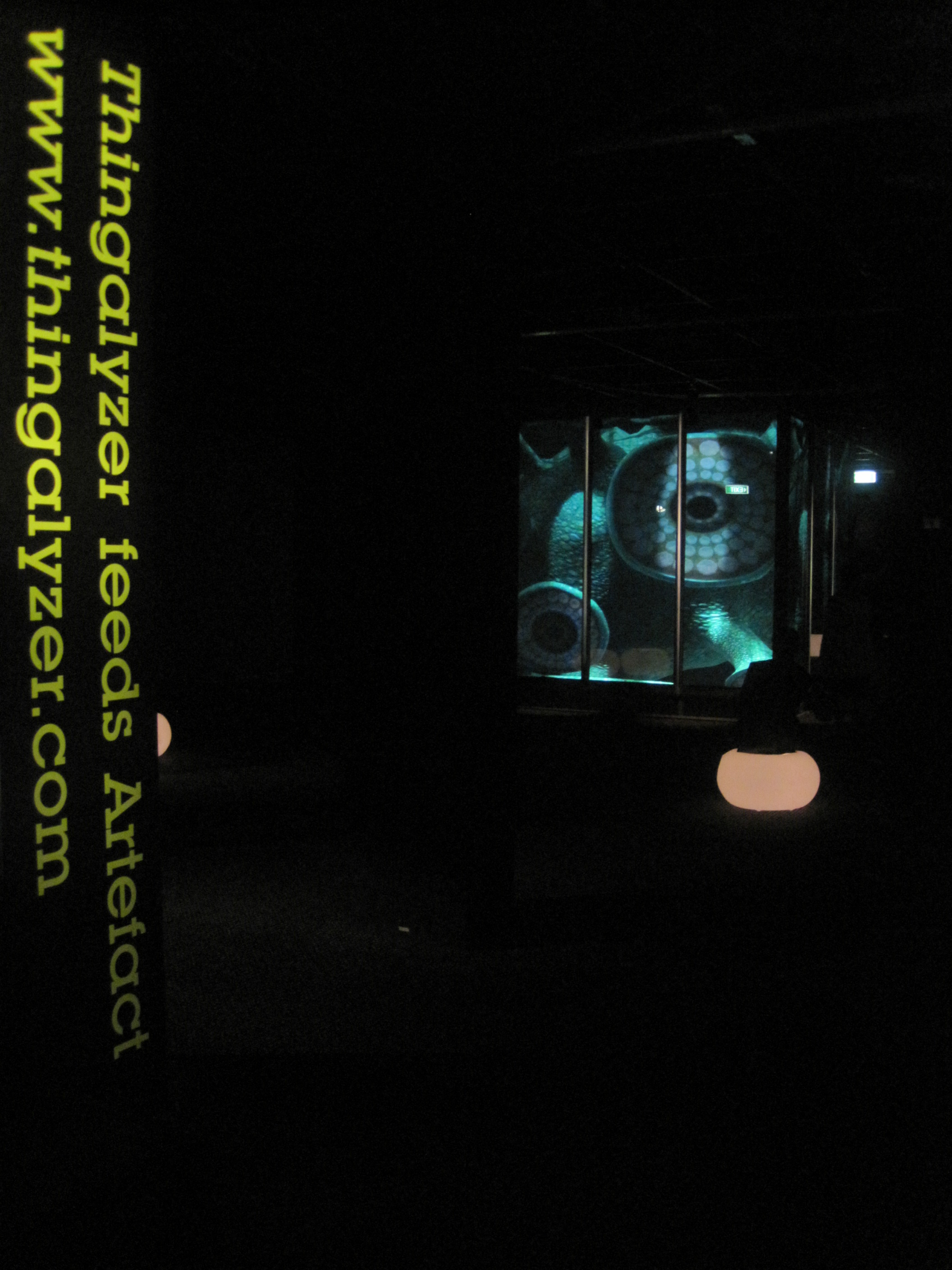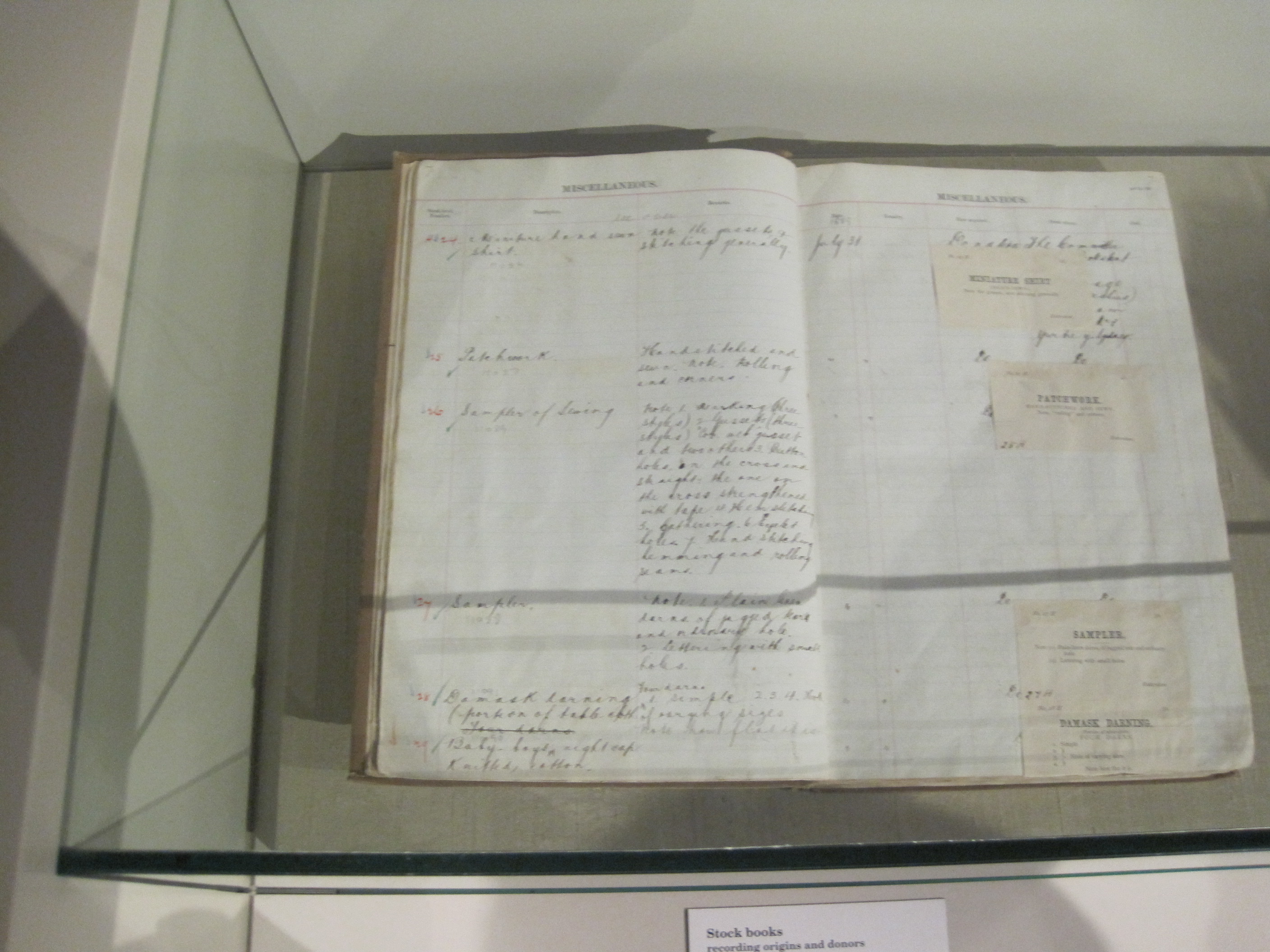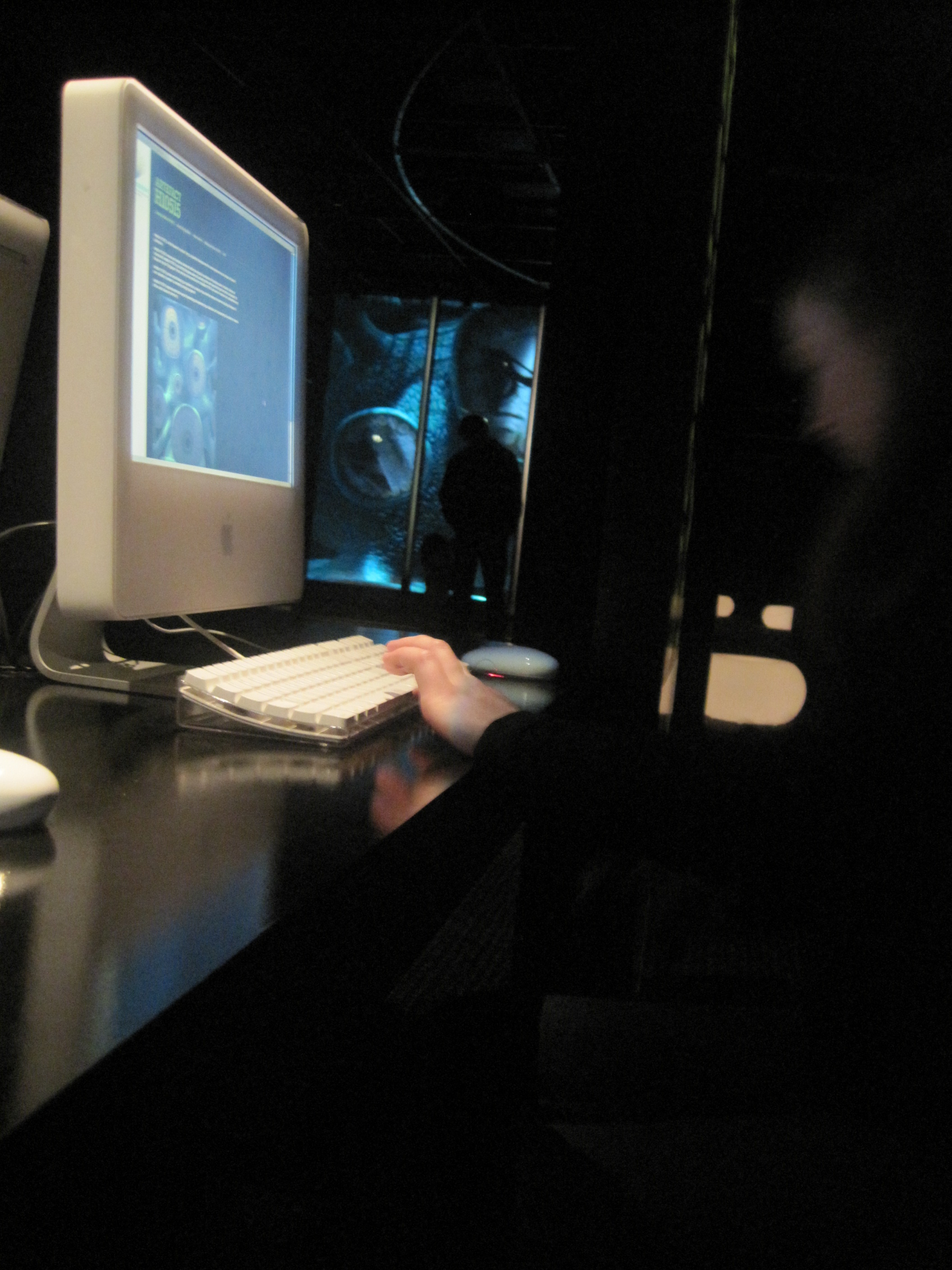Does a digital creature need THINGS? Craig Walsh's Artefact H10515 @ the PHM
by Deborah Turnbull on 10 SEP 2009
 It was 9:00am one work-a-day morning when my boss told me to round up my fellow PHM staff. We were to go to training at Switch House Level 1 for a new artifact on exhibition in the museum. Where I had been yawning and rubbing my eyes while sorting email, that piece of knowledge perked me up more than my morning soy mocha had. Apparently this new work was interactive, experiential, immersive, and get this: ALIVE! Rumour had it that it even required feeding…
It was 9:00am one work-a-day morning when my boss told me to round up my fellow PHM staff. We were to go to training at Switch House Level 1 for a new artifact on exhibition in the museum. Where I had been yawning and rubbing my eyes while sorting email, that piece of knowledge perked me up more than my morning soy mocha had. Apparently this new work was interactive, experiential, immersive, and get this: ALIVE! Rumour had it that it even required feeding…
Where I had a bit of information on “the Artefact” thanks to my good friends and colleagues at IxC (they were working on the website that would feed this new resident), I wasn’t sure what to expect of a more finished product. In truth I had snuck into the gallery a few times over its installation, as the lure of a high quality interactive display in collaboration with Craig Walsh and some of the top interactive web designers in the country was too much to bear. If sneaking into a closed gallery is a walk on the wild side for me, seeing the finished product had me tingly all over.
Education co-ordinator Helen Whitty met us outside the gallery. Because she’s quite a fun education co-ordinator, she demonstrated with human subjects (us!) how the artifact was nourished through images gathered from Flickr* and how it linked to the PHM collection. As you can imagine, much laughter ensued when one of the staff was asked to impersonate the Internet and we were met with a look of sheer panic of the magnitude of that task. The internet turns out to be the spoon in the feeding of said artifact and the Flickr* images, drawn together by the audience members who type in their subject at computer terminals, are the sustenance.
She then explained the cumbersome name of the artifact, which was in fact Artefact H10515 (think H-ten-five-one-five). Though this was (apparently) a new dawn  for immersive exhibitions at the PHM, management wanted to keep the acquisition process historically accurate. Indeed, the old log books containing registration details were the only “hands off” items in the exhibition and were displayed under glass on a plinth outside of the actual gallery. It seemed that the delineation between the old and the new way to display museum items was very deliberate, and being enforced spatially as well as epistemologically. Turns out they still want us to learn through the traditional cold removalist approach as well as the new fangled osmotic approach of sensory absorption supported by digital technology. The staff was certainly game to give it a go, so in we traipsed.
for immersive exhibitions at the PHM, management wanted to keep the acquisition process historically accurate. Indeed, the old log books containing registration details were the only “hands off” items in the exhibition and were displayed under glass on a plinth outside of the actual gallery. It seemed that the delineation between the old and the new way to display museum items was very deliberate, and being enforced spatially as well as epistemologically. Turns out they still want us to learn through the traditional cold removalist approach as well as the new fangled osmotic approach of sensory absorption supported by digital technology. The staff was certainly game to give it a go, so in we traipsed.
We were met with a huge space where dim lighting and audible breathing were the first thing one sensed. The hypnotic effect of the breathing lulled one into a false sense of almost womb-like security. As my eyes adjusted to the bric-a-brac go-bo lighting (think spooky trees backlit by a full moon) I focused on a large rectangular box in the centre of the room on which a digital being was displayed in all its glory. Functioning as the nucleus of cell, an octopus-like creature featuring reptilian skin and suction cups at the end of snake-like tendrils moved rhythmically between the four screens that appeared to house it. The internally lit designer chairs that dotted the space resembled pods, perhaps distributed a la Ridley Scott’s Aliens from the mother creature <eeeeeeep!>. Though they were meant to invite further contemplation via a seated view, I couldn’t shake the feeling that another “artifact” might spring from a pod at any time. As such, I thought keeping my bottom away from them was a good idea. When I was able to tear my eyes away from the creature, I viewed video reel of collaborators’ interviews, screen footage of Walsh’s previous works (all equally immersive and a bit more ethereal) and surveyed the computer terminals that housed the Thingalyser website that fed the creature. After a while, we were pulled away to start the working day, fully armed with information about our newest exhibition.
The thing is, we didn’t really know what to tell people. The interaction seemed limited to a point and click internet interface where you may or may not see the resultant image encircled by octopus suckers. It was a bit of a head-scratcher, but also eerily compelling. I didn’t want to leave the room. Its as though management expected this though, as we had a shiny new button on our tills to prompt us to tell folks about it and enquire whether they had come to the museum the specifically see the Artefact. I spent the morning a little numb, missing the re-created womb and wondering when the interactive elements would be installed so that I could become better acquainted with the system through tactile manipulation. I was a little buoyed when my tech manager (and IxC insider) offered to take me along to the launch as his +1, thinking surely they wouldn’t launch it without the interactive elements!
Over the next weekend, Switch 1 was closed while they wrestled with getting the interactives online. That Tuesday night, Aram and I went along to the launch, listened to the talks, had a few drinks, caught up with friends, and ate what was likely more than our fair share of canapé. When we went over to the exhibit, there were subtle changes; the images was sharper, Aram explained some of the reptilian skin creation to me, there were more people around talking about interactivity and the study of exhibition over the history of museums, and of course the artist was mingling and shots were being snapped by the in-house photographer. The moment of truth had arrived…would the system be tactile? If so, how so?
I pressed my fingers against the glass at the closest sucker tendril and dragged it across the surface. Nothing. Aram tried tapping his finger at different points. Nothing. We approached our interactive guru at the museum and asked him about the process of installing the interactive elements. He knew nothing. We approached education, they knew nothing. We asked Aram’s bosses, they knew nothing. Apparently they could launch it without the interactive elements ready, which perhaps makes Craig Walsh more of a superstar than I initially took him for. I glanced around the room, hoping to talk to him and noticed that all the people we had spoken to were doing the same thing. Helen Whitty was the first to speak out, “Where’s Craig?” and a flurry of activity ensued locating the photographer and Craig, and apparently his mother, who had come along as his +1.
 Resigned to drinking and eating more, we snapped some photos and left the space (again, reluctantly on my part). As the night wound down, I stood with our group of friends, laughing and talking, drank a little more, and lo and behold got recognized by Artistic Director of Artistic Programmes at the MCA, Judith Blackhall (high 5’s all around ladies and gentlemen!)! When I headed over for more drink, she actually broke away from her group, including said superstar artist and his mother, to apologise for missing the launch of my show at the UTS Tower. She did thank me for the invite and then proceeded to talk with me for the next 20 minutes about different exhibitions. Christopher Snelling (site manager at the PDC) did saunter over with a smile in his eyes to ask me what I was up to (likely he was quite interested as to why I was schmoozing arguably the most powerful woman in the programming of contemporary art in Sydney, save her boss, Liz Ann Macgregor). During these glorious 20 minutes, we three talked about our art collections, what we were doing in the new year, and of course, how that affected everything else in Sydney. I was also able to show her Beta_space, after which I reluctantly released her back to her group.
Resigned to drinking and eating more, we snapped some photos and left the space (again, reluctantly on my part). As the night wound down, I stood with our group of friends, laughing and talking, drank a little more, and lo and behold got recognized by Artistic Director of Artistic Programmes at the MCA, Judith Blackhall (high 5’s all around ladies and gentlemen!)! When I headed over for more drink, she actually broke away from her group, including said superstar artist and his mother, to apologise for missing the launch of my show at the UTS Tower. She did thank me for the invite and then proceeded to talk with me for the next 20 minutes about different exhibitions. Christopher Snelling (site manager at the PDC) did saunter over with a smile in his eyes to ask me what I was up to (likely he was quite interested as to why I was schmoozing arguably the most powerful woman in the programming of contemporary art in Sydney, save her boss, Liz Ann Macgregor). During these glorious 20 minutes, we three talked about our art collections, what we were doing in the new year, and of course, how that affected everything else in Sydney. I was also able to show her Beta_space, after which I reluctantly released her back to her group.
In the afterglow of this somewhat miraculous experience (so what I actually went back and high-fived my friends or if her colleague snubbed me 5 seconds after David Cranswick from DLux smiled and walked away from me), it struck me then that the boys who concieved the technical support for Beta_space had also constructed the Thingalyser website, food for the Artefact. It seemed that something larger had come out of a conversation we had been having within the museum for almost 5 years, since the creation of Beta_pace in November 2004. If the boys at IxC had evolved in their skill to participate in the dialogue of new interactive arts creation, perhaps there’s hope for me yet!
Visit the Artefact H10515 for a truly immersive (though not yet interactive) experience until August 2010.


Comment on this post